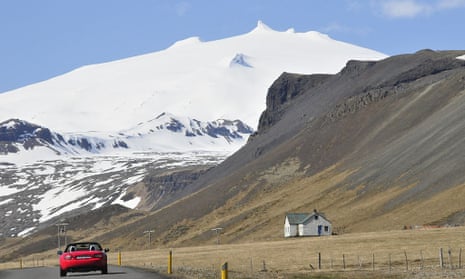Standing in the shadow of Iceland’s Snæfellsjökull, – a 700,000-year-old glacier perched on a volcano and visible to half the country’s population on any given day – in 2010, Angela Rawlings was struck by an unconventional thought.
“It suddenly just came to me. What if the glacier was president?” said Rawlings. It was a seemingly unorthodox way to push forward a movement that was already swiftly advancing; Ecuador had enshrined legal rights for nature while Māori in New Zealand were working to secure legal personhood for the Whanganui River.
More than a decade later, Rawlings’ musing has snowballed into what is perhaps the continent’s most singular presidential bid, as a team of more than 50 people scrambles to secure Snæfellsjökull a spot on the ballot in the country’s upcoming election on 1 June.
Among the first to hear the idea was Daria Testo. “I immediately was like, yup, OK. Let’s do it,” said Testo. “I come from the Indigenous lands in Siberia, and therefore personhood of nature is something that is so common to the culture and the psyche in general.”

On paper Snæfellsjökull meets all of the basic requirements: it is older than 35 years and arguably can be considered a citizen of Iceland. The need for a civil registration number was skirted after Rawlings legally took on Snæfellsjökull as a middle name, in essence allowing the campaign organiser to become a proxy for the glacier on the ballot.
Since officially launching the bid in mid-March, the team behind Snæfellsjökull has been steadily laying out their case for why the thick mass of ice is a perfect fit for a position largely seen as symbolic. “Snæfellsjökull is the one glacier in the country that actually has an international reputation,” said Rawlings, citing its role as a protagonist in Jules Verne’s Journey to the Centre of the Earth.
More importantly, its candidacy would offer a means of ensuring that the climate crisis, and those most affected by it, are front and centre in the election.
“Half the population of Iceland is watching this glacier melt between 2024 and 2050,” said Rawlings, pointing to research suggesting that Iceland’s glaciers are at risk of disappearing within the next 200 years. “I’ve been personally referring to glaciers as the charismatic, geographic phenomenon of the climate emergency.”
So far, they have received a wide array of reactions to the campaign. “We are coming at this with both joy and seriousness,” said Rawlings. “I’m aware that when you first say something like ‘A glacier for president’, it seems like a comedic gesture. But then once you get through that, the conversation opens up.”
Most have been curious to hear more about their rationale rather than jumping to the conclusion that they are making a mockery of the country’s presidential office, said Rawlings. “I’ve actually been surprised by the volume of glee, let’s say, that we’ve been receiving. People are like ‘Oh my gosh, yes, best candidate to come up’ or ‘That’s the only candidate I will even consider.’”
Others have expressed hesitancy about how the idea would work in practice. The team has seized on these concerns to hash out various scenarios, explaining that a bottle of glacial meltwater could be sent when the president is invited to engagements abroad and that visiting foreign dignitaries could be redirected to meetings with local specialists in fields such as glaciology.
When it comes to the president’s often symbolic role in signing off on legislation, the ideas being weighed include using a presidential seal or a few droplets of meltwater. When it comes to legislation that would run counter to the best interests of the glacier; however, the question of whether Snæfellsjökull should exercise the president’s rarely used veto could be put to a nationwide participatory process.
Looming over the presidential bid is one other requirement for candidates: the need to collect at least 1,500 signatures in support of the nomination by 26 April. So far, Snæfellsjökull’s candidacy has gathered about 200 signatures, suggesting there is much work to be done in the coming days in order to advance the candidacy.
Regardless of what comes next for Snæfellsjökull, Rawlings described the bid as a potent “thought experiment” on how humans could seek to interact differently with the ecosystems that surround them.
“Getting on the ballot itself would be a huge step for increasing awareness around the rights of nature movements internationally,” said Rawlings. “It would set an extraordinary precedent to be considering non-human entities for these kinds of positions.”
